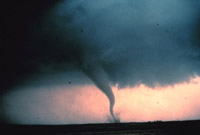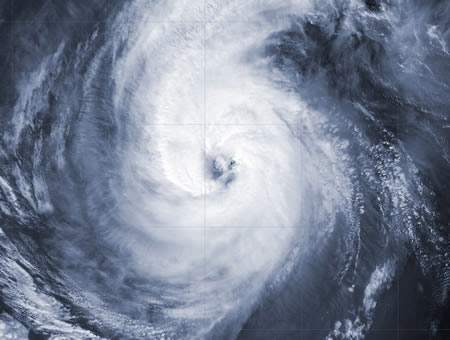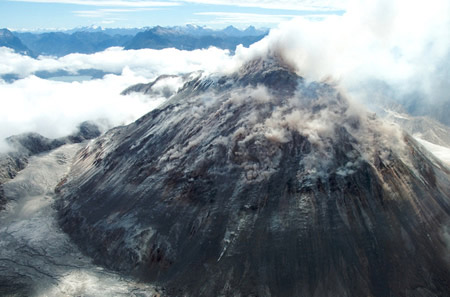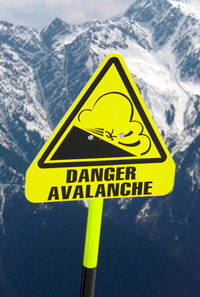Lesson: Save Our City!
 (Lesson plan courtesy of TeachEngineering)
(Lesson plan courtesy of TeachEngineering)
Grade Level: 4 (3-5)
Time Required: 50 minutes
Group Size: 1 (Expendable Cost Per Group : US$ 0)
Summary
Students learn about various natural hazards and specific methods engineers use to prevent these hazards from becoming natural disasters. They study a hypothetical map of an area covered with natural hazards and decide where to place natural disaster prevention devices by applying their critical thinking skills and an understanding of the causes of natural disasters.
Engineers must understand the causes and behavior of our planet’s natural events so they can help people survive natural disasters. They design devices that help us minimize, eliminate or predict the effects of a natural hazard. Detecting, predicting and warning about hazards help populations evacuate and/or seek shelter. They design mountain, ocean, earth and atmospheric monitoring devices. They design specialized weather instruments, radar and satellites to collect data and make predictions. Sometimes engineers even make devices that trigger smaller hazards in order to prevent larger ones.
Educational Standards
Colorado Science (Grades 0 – 12) [1995]
o 4.1 Students know and understand the composition of Earth, its history, and the natural processes that shape it.
o Standard 5: Students know and understand interrelationships among science, technology, and human activity and how they can affect the world.
o 4.2 Students know and understand the general characteristics of the atmosphere and fundamental processes of weather.
o Standard 1: Students understand the processes of scientific investigation and design, conduct, communicate about, and evaluate such investigations.
More standards can be found here.
Learning Objectives
After this activity, students should be able to:
* Describe several methods that engineers use to predict, minimize or eliminate the effects of a natural hazard.
* Explain that the placement of these devices is important to their effectiveness.
Materials List
Each student needs:
* A copy of the attached Map of Unawaria.
* A copy of the attached Save Our City! Worksheet.
* A set of six natural disaster prevention devices, as cut out of the attached Natural Disaster Prevention Devices Sheet. (20 sets on one sheet)
* Scissors
* White glue or a glue stick
* Crayons (optional)
Attachments
* Map of Unawaria (doc)
* Map of Unawaria (pdf)
* Disaster Prevention Devices Sheet (doc)
* Disaster Prevention Devices Sheet (pdf)
* Save Our City! Worksheet (doc)
* Save Our City! Worksheet (pdf)
* Save Our City! Worksheet Answers (doc)
* Save Our City! Worksheet Answers (pdf)
Introduction/Motivation
A natural hazard is a natural event that has the possibility to cause damage and affect human populations. Some examples of natural hazards include volcanoes, earthquakes, tsunamis, floods, hurricanes, tornadoes, avalanches, forest fires, thunderstorms and landslides. Engineers keep natural hazards from becoming natural disasters, or minimize the effects of a natural hazard. Engineers design many different devices. Some of these include avalanche mortars, tsunami buoys, seismometers, Doppler radar, volcano tiltmeters and water gauges. (Write these on the board.)

Avalanche mortars are designed by engineers to prevent natural disasters by triggering small avalanches before enough snow builds up to cause a catastrophic avalanche. An avalanche mortar is an explosive projectile that is launched at a slope where an avalanche is likely to occur. The explosion shakes the snow loose from the slope, causing a small avalanche. Explosives can also be dropped by skiers. The advantage of the avalanche mortar is that it can easily cover a large area and is safer for ski patrollers so they do not have to ski into dangerous avalanche zones to place explosives. The problem with avalanche mortars is that they are susceptible to wind and a dud mortar leaves a live explosive on the mountain. Without the avalanche mortar, snow levels could build to a point at which a huge avalanche could cause casualties and damage structures.
Because tsunamis often start far out in the ocean, it can take hours for the wave to reach land. Engineers design special buoys (floating devices) that can be left far out to sea to detect tsunami waves early, allowing time for coastal areas to be evacuated. As a tsunami moves across deep ocean water, its wave is usually only a few centimeters high. Special sensors placed on the ocean bottom can detect even small tsunamis. The sensor information is sent to a buoy on the ocean surface from which it is relayed to tsunami centers via satellite. This system is known as DART (deep-ocean assessment and reporting of tsunamis). Tsunami buoys are typically placed far away from the coast so that when they detect a tsunami there is enough time to warn coastal residents.
The most common way of detecting and measuring earthquakes is a seismometer (also known as a seismograph). A seismometer is any device used to detect vibration in the Earth’s surface. A simple seismometer consists of something suspended from springs that are allowed to swing as the Earth shakes. A pen attached the device records all vibrations. Seismometers can be sensitive enough to detect earthquakes that people cannot even feel. Seismometers can detect a powerful earthquake anywhere in the world, but often seismometers are placed near fault lines to detect very small earthquakes. This information can help engineers predict when a large earthquake is due to occur. Faults are the boundaries between the tectonic plates that make up the surface of the Earth’s crust. As the plates slide along each other, they slip and grind, causing earthquakes.
Thunderstorms can form quickly and are not always easy to predict. So, this is why engineers create Doppler radar stations that are able to detect approaching thunderstorms. Doppler radar works by sending out a pulse or radio waves, then measuring how long it takes the wave to bounce off an object and return. In the case of thunderstorms, the radio waves bounce off the rain or hail. Information from the radar station can determine the size of a storm, how fast it is moving, which direction it is moving, and whether or not there is danger of a tornado. Because tornadoes usually occur in flat areas, such as grasslands, radar stations are often placed in these areas.
One indication that a volcano is about to erupt is that the mountain actually grows as magma moves up towards the surface. Unfortunately the change is small and happens fairly slowly so that people usually do not notice it. That is why engineers have developed special devices calls tiltmeters that can detect small changes in the shape of a volcano. These devices are placed directly on the side of the volcano and help us predict any upcoming eruptions.

A basic way of monitoring floods is with a water gauge. A simple water gauge is just a vertical post that is marked with water depths and placed in rivers and streams that often flood (see Figure 5). If the water rises over a certain level, nearby communities can be evacuated to save lives. Engineers have developed some fancier water gauges that automatically relay information to a local data center.
Vocabulary/Definitions
Avalauncher: A device used to launch explosives (an avalanche mortar) onto avalanche-prone slopes in order to trigger small avalanches so that large avalanches do not form.
Buoy: A floating device.
DART: Deep-ocean assessment and reporting of tsunamis system. A collection of sensors and buoys that detect potential tsunamis and warn people in coastal areas.
Doppler radar: A type of weather radar that is used to detect precipitation and track the speed and direction of a storm.
Engineer: A person who applies her/his understanding of science and mathematics to creating things for the benefit of humanity and our planet.
Seismometer: A device for detecting and measuring the intensity of an earthquake. Also known as a seismograph.
Tiltmeter: A device placed on a volcano that can detect changes in the size of the volcano due to increased magma volume. Used to help predict impending eruptions.
Procedure
Before the Activity
* Make two copies of the Natural Disaster Prevention Devices Sheet. Cut the sheets so that each student gets a strip with each of the six different devices; there are 20 sets on a sheet.
* Make copies of the Map of Unawaria, one per student.
* Make copies of the Save Our City! Worksheet, one per student.
With the Students
1. Tell the students a background story about Unawaria and natural disasters. For example: “The prime minister of Unawaria has just called me, and she is worried about natural disasters causing destruction in the city of Merryville and the small city of Bliss Town. She says she wants our engineers to place some special disaster prevention devices around her country to minimize the impact of the many natural hazards in and around Unawaria. Unfortunately, we have only a small budget for this project, so we only can place six different devices around the country. It is up to us to decide where these devices go so they best protect populated areas.”
2. Briefly explain the six different disaster prevention devices (tsunami buoy, volcano monitor, Doppler radar, water gauge, seismometer, avalanche mortar) and where they are usually placed in order to help prevent natural disasters.
3. Hand out a map to each student and lead a class discussion about the different natural disasters that could occur in this country.
4. Next, pass out the strips of the six different disaster prevention devices to the students.
5. Have them cut along the lines to separate them into six pieces.
6. Working individually, have students decide where they think each device should be placed in order to best help prevent a natural disaster or predict a disaster so that lives can be saved. Have them glue their devices to their maps at those locations.
7. Next, have them complete the Save Our City! Worksheet. (Note: Make sure to hand out this worksheet only after the students have completed gluing their devices on their own maps.)
8. (optional) While waiting for the rest of the class to finish, students may color their maps and devices.
9. Review the map and worksheet with the class. There are no absolute right and wrong answers as long students are able to logically justify where they placed their devices. With everyone’s ideas pooled together, can we agree on what are the best placements for each device?
10. Conclude by conducting the post-activity assessment activities described in the Assessment section.
Safety Issues
Be sure the students are careful with scissors, or do all the cutting in advance of the activity.
Troubleshooting Tips
Remind students that there is no one right place to put each device, although there are placements that do not make sense (such as a tsunami buoy placed in the mountains). Their choices may be correct as long as they can provide good reasoning for where they place their devices.
Assessment
Pre-Activity Assessment
Discussion Questions: Solicit answers to the following questions and explain to the students that we will answer these questions as we explore the activity.
* Is it necessary to monitor every natural hazard in order to prevent a natural disaster? (No, there are natural hazards that exist in remote areas where there is no threat to humans.)
* Can anyone name any devices or methods we use to predict, eliminate or minimize the effects of a natural disaster? (Examples: Seismometers, avalanche mortars, water gauges, volcano tiltmeters, tsunami buoys, Doppler radar, sensors, communication and warning devices, weather satellites and forecasts, levees, structures, fire fighting equipment, etc.)
Activity Embedded Assessment
Worksheet: Have students complete the Save Our City! Worksheet; review their answers to gauge their mastery of the subject. After students finish working individually on worksheets, have them compare answers with a peer, giving all students time to finish their worksheets.
 Voting: Have students vote on the following true/false questions and then explain the answers.
Voting: Have students vote on the following true/false questions and then explain the answers.
* True or False: Avalanche mortars prevent avalanches from occurring. (Answer: False, avalanche mortars trigger small avalanches so that large avalanches are not likely to occur.)
* True or False: Tsunami buoys should be placed close to shore in order to better protect the coast. (Answer: False, tsunami buoys should be placed in the ocean far from shore so that residents have time to evacuate.)
* True or False: A seismometer can detect a strong earthquake anywhere in the world. (Answer: True)
* True or False: Tiltmeters measure the tilt on an avalanche slope. (Answer: False, tiltmeters measure the change in the shape of a volcano.)
* True or False: Tornadoes typically form over flat areas such as grasslands. (Answer: True)
Post-Activity Assessment
On the Map/Worksheet Discussion: Draw a rough version of the Map of Unawaria on the chalk board and have several students come up to the board to show where they think the devices should go. Have students explain their reasoning for choosing their locations.
Worksheet: After students complete the attached Save Our City! Worksheet, explain that they work for an engineering firm and the interns made their best guesses as to where the devices should be located. Now, as expert engineers, the students can help the interns place the devices correctly. Review and discuss the worksheet with the entire class. Have the class generate a list of “mistakes” and have them describe “improvements,” explaining why they would move the device elsewhere.
Extensions
Have students identify other natural hazards on the map or add a natural hazard to the map. Then, have them use an existing device or design their own device that would help keep the new natural hazard from becoming a natural disaster.
Scaling
* For lower grades, discuss as a class where the devices would be best placed and go through the worksheet together. Make sure all the students are writing down the class decisions (that is, the mistakes on the map) throughout the discussions.
* For upper grades, tell the students how the natural disaster prevention devices work, but do not give them information on where they are usually placed. Challenge them to decide where to place the devices without this information.
References
About Earthquakes, Earthquake Hazards Program. U.S. Geological Survey, U.S. Department of the Interior. (Facts and terms, educational topics, resources)
Avalanche Center (CSAC) – Snow and Avalanches. The Avalanche Center.
Doppler radar. Wikipedia, the free online encyclopedia.
National Data Buoy Center (NDBC) – Deep-ocean Assessment and Reporting of Tsunamis (DART). National Oceanic and Atmospheric Administration. (Link to DART international real-time data)
Sawall, Hardy. Avalanche Defense Techniques. Michigan Technological University.
Watson, John and Kathie. Predicting Earthquakes – General Interest Publication. U.S. Geological Survey.
Contributors
Geoffrey Hill, Malinda Schaefer Zarske, Denise Carlson
Copyright © 2006 by Regents of the University of Colorado. This digital library content was developed by the Integrated Teaching and Learning Program under National Science Foundation Grant No. 0338326.
Supporting Program: Integrated Teaching and Learning Program, College of Engineering, University of Colorado at Boulder
“Tornado” by National Oceanic and Atmospheric Administration (Wikipedia Commons)
“Hurricane Norbert” by Core Burn (Flickr Commons)
“Volcán Chaitén” by Sam Beebe (Flickr Commons)
“Danger Avalanche” by PSD (Flickr Commons)
Filed under: Class Activities, Grades K-5, Grades K-5, Lesson Plans
Tags: Class Activities, Curriculum, Lesson Plans, Resources for Teachers, Teaching Aids








